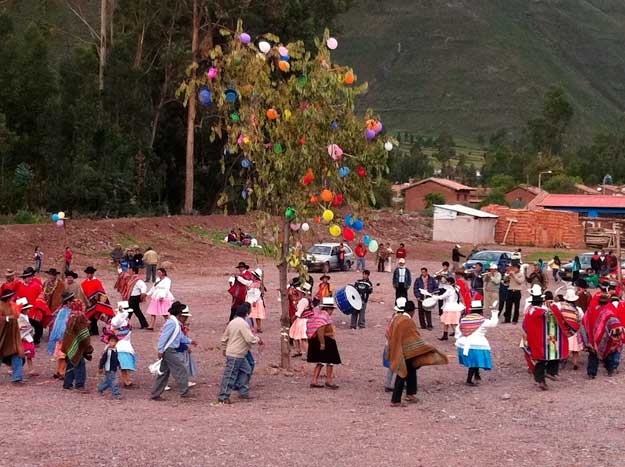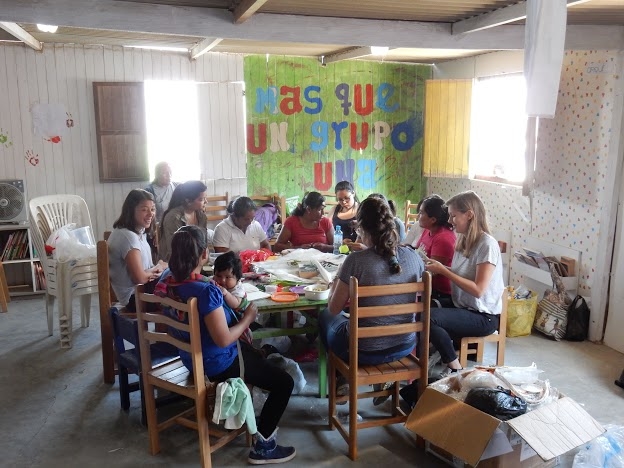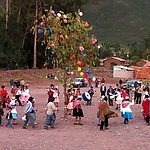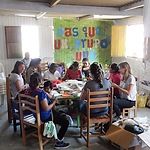History of Manchay
Last sunday we went to visit the weavers in Manchay again. The first time we went to Manchay was to meet the women and to see how they are working in the Ruwasunchis community and helping them cutting plastic bags. We could notice that the women were very shy the first time we met them, but this time was different! They recognized us and we helped them again with cutting plastic bags and now they seemed to talk more and it was very cosy to work with them! We sang a few Dutch songs for them from Guus Meeuwis and Sinterklaas Kapoentje, en the women sang a few songs in Quechua (native language from the highlands of Peru) for us! They brought lunch for us again, delicious aji de tallerines (spaghetti with a pepper sauce and a boiled egg).
Since we are working together with a designer (Marta Sif; see article Marta Sif) we made an evaluation of Manchay by asking the women some questions Marta gave us in order to gain more background information of how the community is set-up and about their traditions and habits. By this mean Marta can achieve more inspiration for her designs!
What is the story of Manchay and why do people live there?
The history of Manchay and its surrounding areas goes back until the 1960’s. The Ruwasunchis community, located in San Pablo Mirador and founded in 1995, is an extension of ‘Portada 2’ founded in 1994. Back in these years there existed a lot of terrorism (Caused by: Sendero luminoso; the communist party of Peru and MRTA (Movimiento Revolucionario Túpac Amaru)) in the highlands which made people migrate from the highlands towards Lima. For these people who migrated from the highlands living in the center of Lima was too expensive so they settled in the outskirts of the city. In this area existed a lot of private owned but unused land which the migrators invaded. Another reason to migrate from the highlands to the city was to seek for more opportunity in life: a better job. Most of the people who nowadays live in Manchay came from the Ancash region, Apurímac region, Huancavelica city and Ayacucho city. The oldest generation now living in Manchay is the second generation: their parents moved from the highlands towards Manchay during their childhood. They try to preserve their highland traditions but the bigger the age distance is between the generation coming from the highland and the generations now living in Manchay, the more the traditions are being forgotten. Despite of the area nowadays being more urban the women still share their knowledge, food, traditional medicines and family issues.
What is the main occupation?
The main occupation differs a lot between men and women. For men the main jobs consist of construction or mechanical jobs, they travel into the city center everyday to work. The women’s main occupations are either service jobs like cleaning houses in the city Lima or shop owners in Manchay. (like bodega’s or little supermarkets) In their ‘’free time’’ the women weave products that they sell to generate some additional income.
What do people do to entertain themselves?
Adults in Manchay don’t have a lot of free time. The time they have left during the day is filled up with other activities to make more money. As we quote: ‘’weaving and knitting is what we do in our free time’’. They seem to enjoy this. Only on saturday evening they sometimes enjoy some musicians who play cumbia music in the local bar called ‘Huertos’. Though the children have a lot of free time and they like to play outside. They made all kinds of little toys to enjoy themselves and they’re playing soccer or hide and seek. There is already some playground equipment like a swing and a seesaw.
Are there any traditions there?
- Houses are very fragile here and build out of very fragile material. So if someone is able to pay the huge amount for building a real roof (of cement) on top of their house: that’s a very good reason for a party!
- They sing and dance to traditional music from the highlands that their parents taught them. This is called Criolla (https://www.youtube.com/watch?v=Om6QenBBEFs)
- The day of San Pablo de Mirador is the holy day of Saint Paul and this is also celebrated with a big party and a procession. On this special day they don’t wear traditional clothing.
- Yunza - this day is celebrated in february and march - is a kind of carnaval. It’s the feast where the ‘godfather’ and the ‘godmother’ of Manchay’s blocks are being chosen. During these two months there’s a party every weekend and each weekend another cuadra organises the party. In Manchay they call the cuadras ‘manzana’s’.(apples)There is a big Calipto-tree ( it actually doesn’t matter what kind of tree it is) standing in the middle of the party place. This three is filled with balloons and presents. Everyone dances around this tree with gifts in traditional clothing and the first ones to fell this treewill become the grandmother and the grandfather for the next year! Being a godfather or godmother in Manchay is a big honour. What this actually means is that you’ll get all the presents underneath the tree and you’ll have to pay for the event the next year. The grandmother takes care of all the gifts and the grandfather takes care of the tree. This is a big thing for them so around the year they’ll save money so they can afford this party. Just imagine: getting the tree to Manchay costs 500 soles (140EUR) and for the band an additional 2000 soles (560). And add the presents onto that, this party costs a fortune. The band consists of an accordion, guitar, harp, violin and flute. They like to imitate their traditions of the highland. That’s what they value.
- Another interesting thing is that Christmas is not a special party of festive day for them. Just eating with family at home. One of the women mentioned that at the beginning of the community everyone was very close and they celebrated christmas together but as the time went by the and the area became more urban people became more individualistic.
Are there any objects, clothing, accessories that they use that is traditional for this area?
The only traditional thing in Manchay is a Iclla. This is a blanket made in Peruvian print for the women to carry the baby on their back.
Do the weavers have other material that we could possible work with like wool yarn?
Now they only work with wool, cotton and plastic bags. The wool they work with is 85% acrylic and 15% alpaca.
Do they have any other equipment that could be useful?
Besides the crochet-hook, knitting needles, a pair of scissors and a centimeter they don’t have other equipment.
How do the weavers get paid?
For the products made of wool ( scarves, caps, gloves) they get a fixed price per product. These products have to go through a quality control and once they are sold they get paid a bit extra. For the products made out of plastic they don’t know what their income per product will be but they have been insured that this will be in the same proportion as their other products. It is important to keep in mind that the women can’t invest a lot of time without any perspective of earning money. Therefore it’ll just take too much of their time. Their needs are not in the future, their needs are here now.



